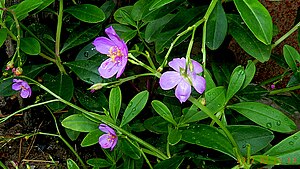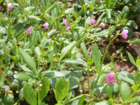Note: This is a project under development. The articles on this wiki are just being initiated and broadly incomplete. You can Help creating new pages.
Talinum triangulare
Waterleaf is a short-lived, erect, strongly branched, perennial plant with succulent stems 30 - 100cm tall growing from swollen, fleshy roots. The plant is often harvsted from the wild for local use as a food. It is also cultivated in various parts of the tropics for its edible leaves, being grown on a particularly large scale in Africa. It is sometimes planted as an ornamental pot plant or as an edging plant in gardens.
Contents
[hide]- 1 Uses
- 2 Parts Used
- 3 Chemical Composition
- 4 Common names
- 5 Properties
- 6 Habit
- 7 Identification
- 8 List of Ayurvedic medicine in which the herb is used
- 9 Where to get the saplings
- 10 Mode of Propagation
- 11 How to plant/cultivate
- 12 Commonly seen growing in areas
- 13 Photo Gallery
- 14 References
- 15 External Links
Uses
Parts Used
Chemical Composition
It contains bioactive compounds namely flavonoids (69.80±4.42 mg/100 g and 58.33 ± 9.00 mg/100 g), alkaloids (55.56±5.00 mg/100 g and 13.89±5.00 mg/100 g), saponins (1.48±0.20 mg/100 g and 1.37±0.60 mg/100 g) and tannins.[2]
Common names
| Language | Common name |
|---|---|
| Kannada | |
| Hindi | |
| Malayalam | |
| Tamil | Sambar keerai |
| Telugu | |
| Marathi | |
| Gujarathi | |
| Punjabi | |
| Kashmiri | |
| Sanskrit | |
| English | Ceylon Spinach, Waterleaf |
Properties
Reference: Dravya - Substance, Rasa - Taste, Guna - Qualities, Veerya - Potency, Vipaka - Post-digesion effect, Karma - Pharmacological activity, Prabhava - Therepeutics.
Dravya
Rasa
Guna
Veerya
Vipaka
Karma
Prabhava
Habit
Identification
Leaf
| Kind | Shape | Feature |
|---|---|---|
Flower
| Type | Size | Color and composition | Stamen | More information |
|---|---|---|---|---|
| {{{5}}} |
Fruit
| Type | Size | Mass | Appearance | Seeds | More information |
|---|---|---|---|---|---|
Other features
List of Ayurvedic medicine in which the herb is used
Where to get the saplings
Mode of Propagation
Seeds, Cuttings of young shoots.
How to plant/cultivate
Grows best in the moist humid conditions of lowland tropical areas, though it can succeed at elevations up to 1,000 metres.[5]
Commonly seen growing in areas
On roadsides, Waste places, Forest edges.
Photo Gallery
References
- Jump up ↑ Indian Medicinal Plants by C.P.Khare
- Jump up ↑ Chemistry
- Jump up ↑ Common names
- Jump up ↑ [Morphology]
- Jump up ↑ Cultivation
External Links
- Ayurvedic Herbs known to be helpful to treat Measles
- Ayurvedic Herbs known to be helpful to treat Diabetes
- Herbs with Leaves used in medicine
- Herbs with Flowers used in medicine
- Herbs with common name in Tamil
- Herbs with common name in English
- Habit - Perennial
- Index of Plants which can be propagated by Seeds
- Index of Plants which can be propagated by Cuttings of young shoots
- Herbs that are commonly seen in the region of On roadsides
- Herbs that are commonly seen in the region of Waste places
- Herbs that are commonly seen in the region of Forest edges
- Herbs





